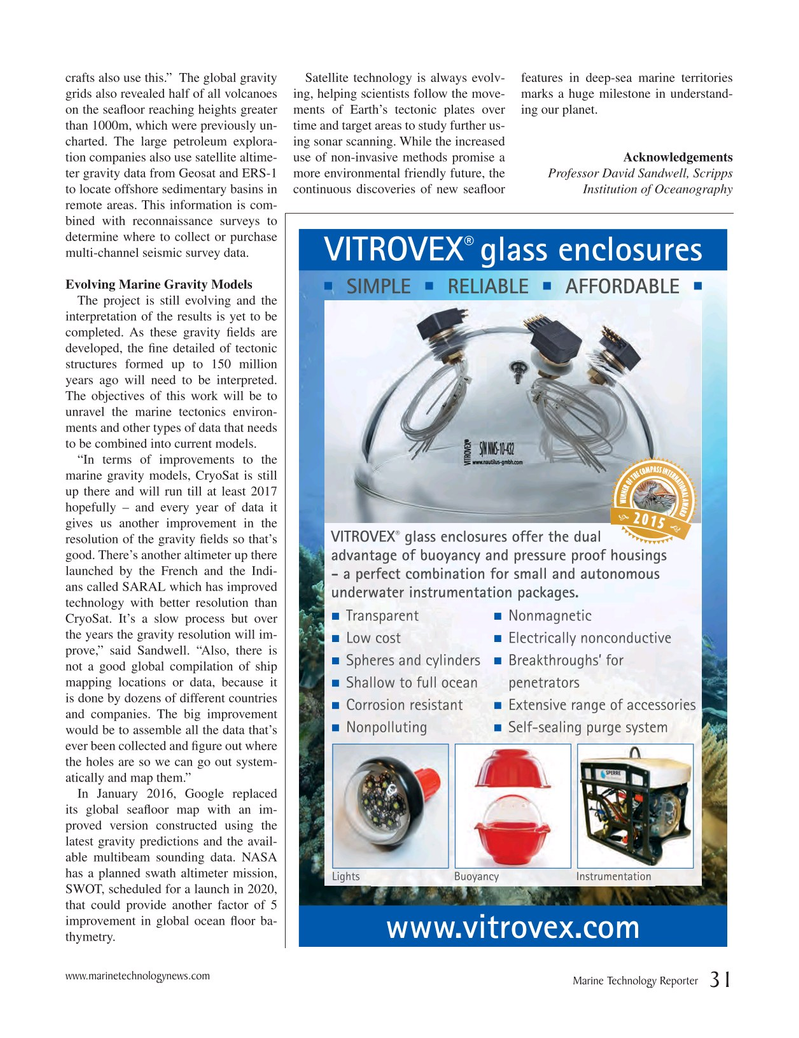
Page 31: of Marine Technology Magazine (March 2016)
Oceanographic Instrumentation: Measurement, Process & Analysis
Read this page in Pdf, Flash or Html5 edition of March 2016 Marine Technology Magazine
crafts also use this.” The global gravity Satellite technology is always evolv- features in deep-sea marine territories grids also revealed half of all volcanoes ing, helping scientists follow the move- marks a huge milestone in understand- on the sea? oor reaching heights greater ments of Earth’s tectonic plates over ing our planet. than 1000m, which were previously un- time and target areas to study further us- charted. The large petroleum explora- ing sonar scanning. While the increased tion companies also use satellite altime- use of non-invasive methods promise a Acknowledgements ter gravity data from Geosat and ERS-1 more environmental friendly future, the Professor David Sandwell, Scripps to locate offshore sedimentary basins in continuous discoveries of new sea? oor Institution of Oceanography remote areas. This information is com- bined with reconnaissance surveys to determine where to collect or purchase multi-channel seismic survey data.
Evolving Marine Gravity Models
The project is still evolving and the interpretation of the results is yet to be completed. As these gravity ? elds are developed, the ? ne detailed of tectonic structures formed up to 150 million years ago will need to be interpreted.
The objectives of this work will be to unravel the marine tectonics environ- ments and other types of data that needs to be combined into current models. “In terms of improvements to the marine gravity models, CryoSat is still up there and will run till at least 2017 hopefully – and every year of data it gives us another improvement in the resolution of the gravity ? elds so that’s good. There’s another altimeter up there launched by the French and the Indi- ans called SARAL which has improved technology with better resolution than
CryoSat. It’s a slow process but over the years the gravity resolution will im- prove,” said Sandwell. “Also, there is not a good global compilation of ship mapping locations or data, because it is done by dozens of different countries and companies. The big improvement would be to assemble all the data that’s ever been collected and ? gure out where the holes are so we can go out system- atically and map them.”
In January 2016, Google replaced its global sea? oor map with an im- proved version constructed using the latest gravity predictions and the avail- able multibeam sounding data. NASA has a planned swath altimeter mission,
SWOT, scheduled for a launch in 2020, that could provide another factor of 5 improvement in global ocean ? oor ba- thymetry. www.marinetechnologynews.com
Marine Technology Reporter 31
MTR #2 (18-33).indd 31 2/19/2016 11:19:00 AM

 30
30

 32
32
